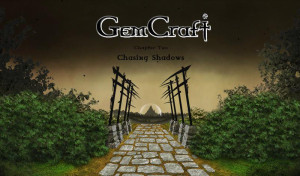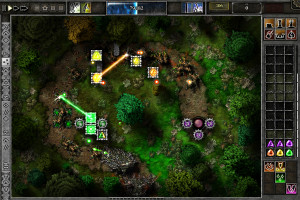The GemCraft series of games have been floating around various flash game portals since 2008. What started as a simple game that fused tower defence with RPG mechanics soon evolved into a highly replayable series that allowed the player to scale the difficulty to suit them, whatever their skill, or however powerful they had become. The latest iteration, GemCraft Chapeter 2: Chasing Shadows, has been in development by Game in a Bottle since 2011, and expands upon some of the difficulty options added in the previous game.
As with most tower defence games, monsters will spawn from the edge of the map and follow a path to the player’s orb. There can be multiple entrances on the map, including nests that may or may not be destroyed. There may also be multiple paths to the orb, and towers or walls can be placed to block off certain routes, or make existing paths long and winding. Mana is the main resource of the game and is accumulated passively over time, or when monsters are destroyed. When the mana pool reaches its limit, the pool gains a level and expands, increasing the percent of XP and mana the player gains for the rest of the level. The magic of the GemCraft series comes from the gems that the player creates which are placed in towers to attack nearby monsters.
In GemCraft:CS there are nine different colours of gem to create. Orange gives mana every time it strikes a target; green poisons; teal reduces health regeneration; blue slows; purple removes armor; yellow can critically strike; red can strike additional targets. Black and white both provide bonus damage and special abilities when mixed with other gems, but use different methods to calculate their bonus. Black scales with the number of hits the gem has made while white scales with the level of the mana pool. Fusing two gems of the same level together creates a single gem one level higher, but the colours do not have to match. A gem can have up to four different colours in it, but the more colours there are in a gem, the less effective their abilities are.
Battles are often won through keeping gems upgraded enough to deal with the increasing toughness of monster waves, while attempting to save enough mana to increase the mana pool level thereby increasing the rate at which mana can be obtained. Some maps will be almost impossible to complete at first, but players can see at a glance how difficult a map is. Completing maps awards the player XP toward their next wizard level, and each level allows the player to spend eight points on various skills that are unlocked by completing tasks in certain maps. As a player gains more skill points and becomes more powerful, old levels can be replayed on higher difficulties, or with special traits in effect that increase the amount of XP a player will gain at the end of a map.
Adding traits to a map cost shadow cores, a new currency added with this iteration of the game, and marks a move to a freemium model for the series. Shadow cores are earned slowly through killing monsters, earning about ten per map to begin with, and more as the number of waves increase. It is unusual to to earn a lot quickly, but a lump sum can be bought if a player wishes to skip grinding cores through regular play. There is also the choice of a one-off payment to unlock extra features, such as Endurance mode. Again, without this the game is a lot slower and much less interesting as endurance is where the challenge lies.
The most interesting feature is also one unique to this version of the game, and that is the talisman. The talisman is comprised of fifteen sockets; five edge, five corner, and five center. fragments have a chance to drop during maps and are shaped to slot into a specific type of socket. Fragments give various bonuses to the player, such as increased damage against specific enemy types, or increasing the initial amount of mana a player starts each level with. Each map can drop varying degrees of fragment rarities, with higher rarities offering greater and more substantial bonuses. Shadow cores are spent to increase the rarity of the next dropped fragment, and also to upgrade fragments. Thankfully, unwanted fragments can also be recycled into cores.
Story has not been mentioned so far because it does not play a major role in the game. The are snippets gained from completing some levels, but its really only there for people who need some explanation for why the player is moving from map to map, or to explain game objects to new players. While the graphics have not changed much from the last game in the series, the engine is now able to handle a far greater number of monsters on the screen at once, and rarely seems to slow down, even with thousands of monsters moving around. The ambient music does little for the game and can just as easily be turned off.
Long time fans of the series may be disappointed to see the introduction of a new currency the can be bought for real money. For as little as $15, the game can be steamrolled over. However, all the depth is still available to free players. The game has also been greenlit on Steam, so only time will tell if a Steam version fixes the issue of buying currency, or allows players to do it all the same. Anyone interested in picking it up on Steam should at least check the flash version out here.


